“Mosquito Fleet” of Microbroadcasters Occupy Seattle FM Dial During NAB Radio Convention, September 10-15, 2002
 Operational Analysis – Behind the mics: a reportback on the fleet’s activities
Operational Analysis – Behind the mics: a reportback on the fleet’s activities
Background
During the week of September 9, 2002, members of the radio industry traveled to Seattle, Washington for the National Association of Broadcasters’ annual radio convention.
 The same week, two other groups of people also began converging on Seattle. Both of these groups came to criticize and challenge the gathering of corporate radio executives and managers, but each had its own idea about how to talk back.
The same week, two other groups of people also began converging on Seattle. Both of these groups came to criticize and challenge the gathering of corporate radio executives and managers, but each had its own idea about how to talk back.
This was not the first time the NAB radio convention has been the focus of protest. When the convention was held in San Francisco in 2000, thousands of people massed in the streets to speak out about the state of radio in America.
At that time, media activists were thick in the fight to try and save the FCC’s new low power FM (LPFM) license system from assassination from the broadcast industry, and much of the protest focused on the potential for the legalization of microradio – the unlicensed version of which has been a form of electronic civil disobedience since the late 1980’s.
There was a real need two years ago to be in the streets, to take such direct action to make the message stick. Two years later, the media democracy movement that began to crystallize in San Francisco is fighting on new fronts, and another confrontation on the streets wouldn’t be as effective.
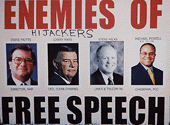 This time around, LPFM exists (but barely), and just another tool to be discussed and strategized upon at the myriad of conferences which shaped the Reclaim the Media! counter-convergence – definitely the more high-profile of the two anti-NAB events that took place Seattle.
This time around, LPFM exists (but barely), and just another tool to be discussed and strategized upon at the myriad of conferences which shaped the Reclaim the Media! counter-convergence – definitely the more high-profile of the two anti-NAB events that took place Seattle.
The second event is the one we’ll cover here. Under the radar of the NAB, and with the tacit support of Reclaim the Media! organizers, a “Mosquito Fleet” of microradio activists from around the country also converged and coordinated a mass occupation of Seattle’s FM radio dial – direct action on the airwaves against the corporate media.
Strategic Goals of the Mosquito Fleet:
1) Debunk the NAB myth that low power FM radio stations cause harmful interference
2) Explain microradio to the public and educate them about the need for community and independent media
3) Demonstrate the potential power of microradio through compelling and coordinated programming
4) Give the radio industry heartburn
Tactical Goals of the Mosquito Fleet:
1) Broadcast on as many open frequencies in Seattle as possible for as long as possible
2) Practice and experiment with coordination between microradio stations in a tactical environment (like a temporary occupation of the FM dial) to simulcast and share programming
3) Perform a simulcast culture jam of Clear Channel’s KJR-FM during the opening day of the NAB convention
Note that none of these goals even mention anything about the Federal Communications Commission, or its ongoing enforcement activities. The perspective of many participants is that the FCC would basically be a non-concern for the duration of the Mosquito Fleet’s cruise. Even so, contingencies had to be covered.
Day 1 – 9/10/02
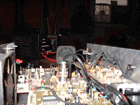 Microradio activists began arriving at the Seattle Independent Media Center in force today to map out plans for the days ahead. In a back room (which would later double as engineering laboratory for the technical/engineering crew), about 20 people gathered in a rough circle of chairs. They came from all over the country – California, Illinois, Florida, Kentucky, Minnesota, New York, Oregon, Texas, and Wisconsin, just to name a few.
Microradio activists began arriving at the Seattle Independent Media Center in force today to map out plans for the days ahead. In a back room (which would later double as engineering laboratory for the technical/engineering crew), about 20 people gathered in a rough circle of chairs. They came from all over the country – California, Illinois, Florida, Kentucky, Minnesota, New York, Oregon, Texas, and Wisconsin, just to name a few.
Planning a mass occupation of the FM radio dial in a major metropolitan area like Seattle is not an easy feat. The first priority is to find vacant channels on the dial where an unlicensed microradio station can operate safely, at minimal risk of interference to other stations. A group of local coordinators spent some 10 months researching possible frequencies for micrbroadcasting.
According to the FCC’s own rules, there should be no space on the dial for any low power FM stations in the Seattle area. The Mosquito Fleet’s very existence should serve to debunk that, and the local coordinators first turned to a copy of the FCC’s original LPFM proposal for guidance on where to start looking for open frequencies.
 All prospective frequencies were situated at least two channels away from any local licensed FM station. The use of these “second adjacent” frequencies was something the FCC originally proposed doing for LPFM in 1999, but rejected in its final rulemaking of January, 2000, in no small part due to pressure from the NAB.
All prospective frequencies were situated at least two channels away from any local licensed FM station. The use of these “second adjacent” frequencies was something the FCC originally proposed doing for LPFM in 1999, but rejected in its final rulemaking of January, 2000, in no small part due to pressure from the NAB.
The Fleet’s frequency coordinators identified 13 potential frequencies in the Seattle area to broadcast on. Because the area is coastal (and therefore very hilly), the topography made for some unique considerations and challenges. Stations running very low power levels (5 watts or less) could conceivably share frequencies with little problem, provided they were sited far enough away from each other.
Of the 13 initial prospects, nine were identified as being the “most clear,” meaning they didn’t have pesky hash from fringe stations cluttering up the channel. These, plus one of the “secondary” channels, became the platforms that various station collectives focused on:
87.9 – Two broadcasters in south Seattle on opposite sides of Beacon Hill, one with 17 watts and the other 4 watts
89.1 – Broadcasting to the Pike/Pine corridor above the reservior
93.7 – Temporary broadcasts from a downtown hotel room
94.5 – Two broadcasters in separate parts of town, one also operating from a hotel room
96.9 – A 4-watt mobile unit that broadcast from a downtown nightclub
99.5 – 40 watts serving north Capitol Hill, Wallingford and the U-District
101.1 – 100 watts, receivable primarly in west/central Seattle
102.1 – 40 watts from central Capitol Hill, serving downtown Seattle and the NAB convention site
104.1 – 75 watts of circularly polarized signal serving all of north Seattle
107.3 – Experimental broadcaster in north Seattle
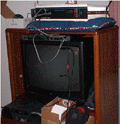 After selecting frequencies, station groups were urged to take copies of a zine specially published for the convergence by SAMBA (the “Second Adjacent Microbroadcasting Association”). Half educational pamphlet and half operational manual, the zine laid out what it was the Fleet was trying to do and included several pages of information on the rights of unlicensed broadcasters with confronted with a visit from the FCC (which seemed unlikely but couldn’t be ruled out).
After selecting frequencies, station groups were urged to take copies of a zine specially published for the convergence by SAMBA (the “Second Adjacent Microbroadcasting Association”). Half educational pamphlet and half operational manual, the zine laid out what it was the Fleet was trying to do and included several pages of information on the rights of unlicensed broadcasters with confronted with a visit from the FCC (which seemed unlikely but couldn’t be ruled out).
Included in the zine was a boilerplate letter to the FCC – the legal shield the Fleet would use if any station got visited. It invoked a clause in the FCC’s own rules which allowed “special temporary authorization” or broadcast stations in a time of national emergency.
In effect, the clause says the FCC may grant emergency licenses to anyone who files an “informal application” to the agency during the emergency. If any station got a knock on the door, it simply handed over an “application to construct a micro-FM station” pursuant to the 47CFR73.3542 – which would initiate the bureaucratic FCC enforcement process and guarantee no further hassle until long after the stations were dismantled and removed from their temporary homes.
Most of the Fleet’s participants brought some sort of working gear with them; by the end of the night stations were one the air at 101.1 (100 watts, broadcasting from the city with a studio-to-transmitter link to a rig somewhere in the woods) and 94.5 (A 35-watt rig run from a hotel room – see photos). Not all collectives arrived completely ready to rock: some had to wait for gear to be shipped from back home while others would need to build critical components on-site.
 Additionally, the different station collectives subscribed to differing levels of security culture: some only went by pseudonyms and kept the locations of their stations a secret, even to the rest of the Fleet’s participants. Others regularly invited people over to their studios for a tour and time on the air.
Additionally, the different station collectives subscribed to differing levels of security culture: some only went by pseudonyms and kept the locations of their stations a secret, even to the rest of the Fleet’s participants. Others regularly invited people over to their studios for a tour and time on the air.
The real process of station construction en masse would begin tomorrow, but having two signals already on the air certainly buoyed everyone’s spirits.
Day 2 – 9/11/02
Today the Mosquito Fleet hoped to launch its first real broadside on the Seattle radio dial. Most folks met back at the IMC to patch together what gear they had and get stations installed and online.
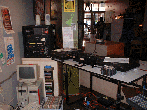 Headaches began here. Some station componentry brought from Texas didn’t match with stuff from Oregon; travel also caused a few equipment casualties, precipitating emergency repairs before some stations could become fully functional.
Headaches began here. Some station componentry brought from Texas didn’t match with stuff from Oregon; travel also caused a few equipment casualties, precipitating emergency repairs before some stations could become fully functional.
Even with the added burden, the core group of broadcast engineers (there were about four, varying from complete DIY techies to folks with a Ph.D.) were able to assemble several four-watt transmitters (most were kits from NRG) and assorted amplifiers, ranging from 20 to 150 watts. The four-watt units not paired up with amplifiers became “floaters” that were set up at special events throughout the week.
 Several types of antennas were employed, including the popular Comet 5/8 wave, 1/2 wave J-pole, and dipole designs. Someone even brought in a circularly-polarized antenna bay to play with, but there wasn’t much success in getting good results with it (perhaps in a more controlled environment).
Several types of antennas were employed, including the popular Comet 5/8 wave, 1/2 wave J-pole, and dipole designs. Someone even brought in a circularly-polarized antenna bay to play with, but there wasn’t much success in getting good results with it (perhaps in a more controlled environment).
In addition to selecting frequencies, the local coordinators had also identified host locations for stations to broadcast from. In many cases, apartment-dwellers invited total strangers into their homes for a week of pirate broadcasting.
These preselected locations greatly speeded up the installation of microradio stations, but they presented their own challenges once the gear was actually in the space. Some antenna locations weren’t as good as first thought, some dwellings weren’t built with proper electrical wiring and grounding, etc. Only one of the stations (an eight-watt outlet installed in a van) was mobile, so everyone else pretty much had to make do with the surroundings they found themselves in.
The entire day seemed heavy with the constantly reverent words and images pummeling us from the mainstream media. After all, it was “one year after,” and proper media genuflection set the initial emotional tone of the day. Reports of police massing a block from the IMC flickered through the space, sparking a flash of nervousness until somebody realized they were there for Seattle’s “remembrance ceremony.”
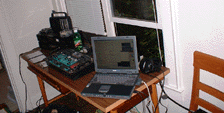 If there was a good day to set sail with the Mosquito Fleet, today was it. By Wednesday evening, four microradio stations were on the air at 87.9, 94.5, 101.1 and 102.1 FM. “System P,” the station at 102.1, had assembled a special 9/11-themed show constructed entirely out of audio collage from the past year’s news. Other Fleet stations linked up to relay the programming.
If there was a good day to set sail with the Mosquito Fleet, today was it. By Wednesday evening, four microradio stations were on the air at 87.9, 94.5, 101.1 and 102.1 FM. “System P,” the station at 102.1, had assembled a special 9/11-themed show constructed entirely out of audio collage from the past year’s news. Other Fleet stations linked up to relay the programming.
It was a great dress rehearsal for the full-on anti-corporate radio assault that would take place on Thursday. Most stations powered down for the night, although over the course of the week several stations broadcast for most of the day (101.1 FM led the way, committing to programming every day from 7 AM until at least 10 PM).
Day 3 – 9/12/02
 The fun began in earnest at high noon, just as radio industry conventioneers began arriving to check in downtown. In near-perfect synchronization, at least six microradio stations began playing a special 24-minute culture jam of KJR-FM. KJR is a commercial radio station in Seattle owned by Clear Channel Communications, America’s largest radio conglomerate.
The fun began in earnest at high noon, just as radio industry conventioneers began arriving to check in downtown. In near-perfect synchronization, at least six microradio stations began playing a special 24-minute culture jam of KJR-FM. KJR is a commercial radio station in Seattle owned by Clear Channel Communications, America’s largest radio conglomerate.
The culture jam program used actual liners, promos and songs from KJR itself, and was formatted in the same style as KJR. The DJ on the mic, however, was “Jack Diekobisc” – a member of the infamous media collage collective Negativland. Jack’s main role was to hammer home the point – KJR claims to play “only the greatest hits of the 60s and 70s,” but in reality nearly a quarter of its playlist is made up of songs from the 1980s. Jack brought this point up repeatedly as he played the very 80s songs found on KJR’s own playlist.
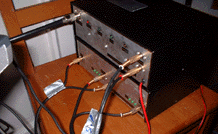 Calling KJR and its program director, Bob Case, “a bunch of liars,” Diekobisc explained how the station skews its playlist in order to attract a younger “money demographic.” But he saved his best vitriol for Clear Channel and the NAB: “They see you as peons, peasants and dollar signs,” ranted Jack, “and they’d think nothing of murdering your family execution-style to protect their bottom line if they had to.”
Calling KJR and its program director, Bob Case, “a bunch of liars,” Diekobisc explained how the station skews its playlist in order to attract a younger “money demographic.” But he saved his best vitriol for Clear Channel and the NAB: “They see you as peons, peasants and dollar signs,” ranted Jack, “and they’d think nothing of murdering your family execution-style to protect their bottom line if they had to.”
We were able to hear six stations performing the simulcast at 94.5, 95.3, 96.9, 99.5, 101.1, and 102.1 FM. There may have been at least three more that joined in after the noon hour, and we do know that some stations continued the loop for as long as seven hours – making sure to hit the ever-popular afternoon “drive-time.”
Some Fleet participants actually infiltrated the lobby of the NAB convention hall and stood around with pocket radios tuned to one of the stations, exposing radio professionals to the zinger themselves. Some were apparently fooled into believing that KJR itself was going through some sort of spasm, and were alarmed to hear the DJ go berserk.
If anything, according to one infiltrator, it “inserted an extremely surreal experience into their day.” KJR must have also gotten the message: on September 17 it modified both the playlist and profile of Bob Case on its website.
That evening, several stations stayed on the air to conduct open-mic broadcasts, recap the day’s events, and taunt the NAB over the air. At least one rogue signal aired a presentation from Negativland’s Mark Hosler live from a local theater, and another coordinated with the Seattle IMC’s web radio station, Studio X, in an experiment involving signal loops, time delay and audio collage. In total, as many as eight different frequencies were occupied throughout the day and night.
The FCC was nowhere to be seen. A sighting of one suspicious person closely inspecting the location of 102.1 was reported, but an actual encounter never materialized, and the man was not seen again.
Day 4 – 9/13/02
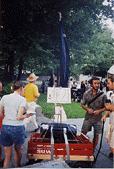 Friday was the opening day of the Reclaim the Media! counter-conference, and many of the panels, discussions and evening events were broadcast online via Studio X.
Friday was the opening day of the Reclaim the Media! counter-conference, and many of the panels, discussions and evening events were broadcast online via Studio X.
Those Mosquito Fleet stations lucky enough to set up at a location with Internet access were able to stream the webcast over the air, allowing media democracy activists to speak directly to the corporate media convention-goers. So long as people with radios stayed inside or close to the Washington State Trade & Convention Center, there would be no way the NAB could escape the scrutiny.
Rallies in a park near the convention site also began in earnest, featuring lots of music all weekend long. An attempt was made to set up a microradio station at the rally, but was thwarted by antenna troubles and the questioning eyes of police, who kept up a visible presence at the park for the duration of the gathering.
That night, the FM dial was alive with at least five signals; some relayed the Reclaim the Media! keynote event while others played and discussed whatever they wanted to. It made for some great radio.
Day 5 – 9/14/02
 Saturday was much like Friday: three or four stations were on the air at any given time during the day, with more appearing during the night. Many of those who ran during the day carried the Studio X feed from more Reclaim the Media! sessions.
Saturday was much like Friday: three or four stations were on the air at any given time during the day, with more appearing during the night. Many of those who ran during the day carried the Studio X feed from more Reclaim the Media! sessions.
There had been some outstanding antenna and power supply shortages plaguing station construction and repair throughout the week, but by today those had been worked out and the number of occupied frequencies surged. That night, as we drove back to our crash pad for a final night of rest before beginning the trip back, we listened a newcomer on Seattle’s “classic” pirate frequency, 89.1 FM – a 150-watt “boomer” station – for a good 20 miles.
Conclusion
Total frequencies occupied: 11
(87.9, 89.1, 93.7, 94.5, 95.3, 96.9, 99.5, 101.1, 102.1, 104.1, 107.3)
Combined power of stations: 440 watts
Station coverage area ranges: 2-20 miles
Number of interference complaints: 0
Most who worked on the microbroadcast activity were exhausted but very happy with what they were able to accomplish by the end of the week. Some stations signed off on Saturday night and were dismantled, but at least four broadcast through Sunday. By the time the Mosquito Fleet had officially disbanded it was early into the following week, and it left four operational microradio stations behind in Seattle.
 While everyone worked well together, the Fleet could have definitely used more engineers, and those who were able to bring a complete, working radio station with them were able to conduct the most programming. If it weren’t for the amount of preplanning that took place, there would have been significantly fewer stations on the air.
While everyone worked well together, the Fleet could have definitely used more engineers, and those who were able to bring a complete, working radio station with them were able to conduct the most programming. If it weren’t for the amount of preplanning that took place, there would have been significantly fewer stations on the air.
Having proven that it’s possible to conduct a temporary mass occupation of a city’s FM dial, several Mosquito Fleet participants plan further experiments with the concept at other protest actions – and at each one, it will hopefully sow the seeds of permanent fleets in its wake.
 Sounds of Seattle – Programming excerpts from the fleet and perspectives from participants
Sounds of Seattle – Programming excerpts from the fleet and perspectives from participants
 Photo Gallery – Images from the tactical battlefield
Photo Gallery – Images from the tactical battlefield
Featured Documents:
 SAMBA Mosquito Fleet Listening Guide (PDF: Adobe Acrobat Reader required)
SAMBA Mosquito Fleet Listening Guide (PDF: Adobe Acrobat Reader required)
Useful to both listeners and broadcasters, this was the manifesto of the event.
 First Steps in Radio (PDF: Adobe Acrobat Reader required)
First Steps in Radio (PDF: Adobe Acrobat Reader required)
A beautifully-designed and very comprehensive technical primer into FM broadcasting. The closest thing to a “field manual” that exists – WELL worth the download. MAD props to Justin Disruption for all the hard work.
Other Coverage of the Mosquito Fleet/Reclaim the Media! Events:
The “official” Reclaim the Media! counter-conference website
Seattle IMC: Media Politics – Tackling the NAB (8/21)
mediageek.net: Preview of Reclaim the Media Conference (8/23)
Seattle IMC: Justice Airwaves Mobilization 101.1 FM Seattle 9/11-14 (9/9)
Seattle IMC: 20 Minutes of Weekday, KUOW (9/11)
Seattle IMC: microBLAST! 2002 (9/11)
Radio4all.net: EBB Microradio Air Check Seattle (9/12)
Seattle IMC: Justice Airwaves Mobilization on 101.1 FM Relayed by Radio X (9/12)
Seattle IMC: Justice Airwaves Mobilization takes it to the Shortwaves (9/12)
mediageek.net: Live Report from Reclaim the Media (9/13)
Urbana/Champaign IMC: Negativland Uses Mosquito Fleet to Bite Clear Channel and the NAB (9/13)
Seattle IMC: Prometheus/Cheap Channel Storm the NAB (9/13)
Seattle IMC: Reclaim the Media Photographs (9/13)
Seattle Times: Broadcast power held by too few, critics say (9/14)
Seattle IMC: NAB Protest Makes Trade Magazines (9/14)
Seattle IMC: Renowned journalists preach democratic media at a packed Seattle Town Hall (9/14)
Seattle IMC: Counter NAB: 16 Billboards “Liberated” (9/15)
Radio4all.net: Micro Radio and Free Speech vs. Corporate Media (9/15)
Seattle IMC: NAB Demo Footage (9/15)
Seattle IMC: microBLAST! 2002 UPDATE (9/16)
Seattle IMC: Photos and MP3s from Reclaim the Media/NAB Protest (9/18)
mediageek.net: The Success of Free Radio Austin and their FCC Bust (9/20)
Seattle Weekly: Inside Radio (9/25)
The Stranger: Radio Static (9/25)
Radio4all.net: Reclaim the Media: Four Conversations on Media and Democracy (9/25)
Seattle IMC: Large Photos from Reclaim the Media/NAB Protest (9/26)
mediageek.net: Monkey Business Behind the Curtain at Clear Channel (9/27)
Radio4all.net: Macaroni Awards 2002 (9/29)
Salon.com: Radio Killed the Radio Star (10/1)
Radio4all.net: Ron Sakolsky – Surrealist Subversions (10/1)
Radio4all.net: Three Speakers on Media and Democracy (10/1)
Radio4all.net: Two More Conversations on Media and Democracy (10/2)
Radio4all.net: Keynote addresses from Reclaim the Media: a Community Media Convergence (10/3)